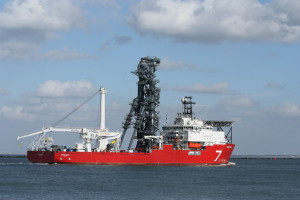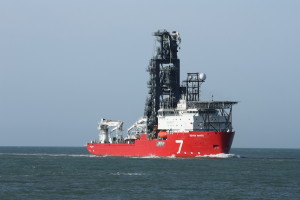Subsea 7’s Seven Waves Seatrials Underway
Today seatrials continued for Subsea 7’s pipelay vessel Seven Waves off the Dutch coast near Rotterdam. Follow seatrials, she is due for delivery to Brazil where she will begin operations for Petrobras. She is the first of a new generation of high-tension pipelayers contracted to Petrobras, according to Subsea 7 Chief Operating Officer John Evans. The 146m vessel had been at Huisman’s Schiedam facility since October last year for installation of mission equipment including her 550t flexlay system and a 400t offshore mast crane. IHC Merwede built the vessel at its Krimpen aan den IJssel yard in the Netherlands.
High Capacity Flexlay System
Seven Waves’ 550t flexlay system is designed and built for the installation of flexible pipelines in 3,000m water depth. The tower is tiltable to allow connection of flexible risers to rigid pipelines, which are retrieved from the seabed. The system’s tensioners are retractable to allow for safe and efficient A&R and PLET installation procedures. They have been designed according to the most stringent requirements and are equipped with a Squeeze Control System, which allows for accurate control of squeeze loads, also at low values. This is important when handling umbilicals.
The 400t deepwater offshore mast crane crane (up to 3,000m) is equipped with a deepwater lowering system and an active heave compensation system to counter-act the vessel’s heaving motion when landing a load on the seabed. These features will make it an efficient tool for the installation of heavy loads required for deepwater subsea production systems. The offshore industry has used Huisman Mast Cranes for over 30 years and the cranes have become a standard in the design and construction of heavy construction vessels.
Pipelay Vessel Shipbuilding
IHC Merwede designed the Lloyd’s Register classed ship in close cooperation with Subsea 7. She has an overall length of 146m, a beam of 30m and a Class-2 dynamic positioning system supplied by Kongsberg. The vessel is equipped with twin ROVs and two under-deck storage carousels, with a capacity for 2,500t and 1,500t of product respectively. She also provides accommodation for 120 persons. Wärtsilä provided the vessel’s diesel electric propulsion package.
Last year’s naming ceremony was carried out by Lucia Andrade, the ship’s God Mother and Subsea 7 Brazil’s Vice President Projects & Operations. Seven Waves is the fifth vessel contracted by Subsea 7 to IHC Merwede.

Subsea 7 pipelay vessel Seven Waves near Rotterdam during sea trials in March 2014. Photo by Robert Davidson.

Subsea 7 pipelay vessel Seven Waves near Rotterdam during sea trials in March 2014. Photo by Subsea 7 pipelay vessel Seven Waves during seatrials in March 2014. Photo by Robert Davidson.
Words by John Gauldie, Offshore Industry
Photos by Robert Davidson







